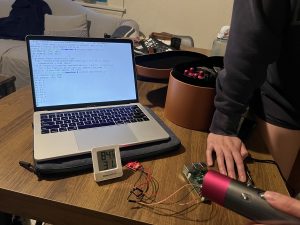A significant risk is that the ML architecture, upon retraining, will not reach an F1 score of .7. However, last time we added the data, the F1 score jumped by .17. Our current best F1 score is .5, so we hope at the very least we can get an F1 score of .67. Another risk is that the hardware doesn’t integrate with the RPi well. However, the temperature sensor is fully integrated. The speaker is on its way to integration, and the GPS sensor is integrated.
No changes were made to the system design. By narrowing our application to the demo, instead of calculating when a radar frame should have inference performed on it using the IMU sensor data, we will instead use a key press to start inference. This has no impact on the cost.

Here is Ayesha and I testing the temperature sensor connected to the RPi. We used a hairdryer to increase the temperature and see the ambient temperature and temperature sensor reading increase accordingly.
Testing Details:
- Machine learning architecture: We unit tested on 600 held-out test samples (collected of diverse scenes and roughly half humans and half no human scenes) measuring resulting F1 score and accuracy. Also, we recorded the inference time of the network.
- Hardware
- Temperature sensor: We have connected it to the RPi and seen the output of the sensor. By comparing the room temperature readings of the temperature sensor readings and the ambient thermometer readings, we saw that the temperature sensor was working at baseline. By using the hairdryer we saw both the temperature on the temperature sensor and ambient thermometer increase.
- Radar: We tested real-time data acquisition at 5Hz on the laptop and connected it to the RPi, but have not tested real-time data acquisition over WiFi yet.
- GPS/IMU sensor: We connected it to the RPi and logged 4927 locations and compared them to the actual stationary location. The location data is precise enough for our updated use case, with a standard deviation of 1.5m, but the location is way off by 20 miles, requiring compensation to output an acceptable location.
- Web application: We have measured that the website updates in ~100 ms. Through HTTP requests, we also found that the web application is able to received formatted data.
Findings:
- The GPS is currently ~20 miles off, so we may need to apply an offset to get accurate readings from the sensor.
0 Comments